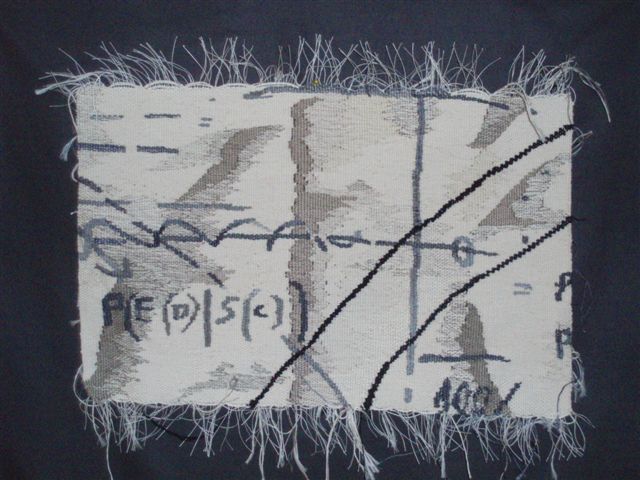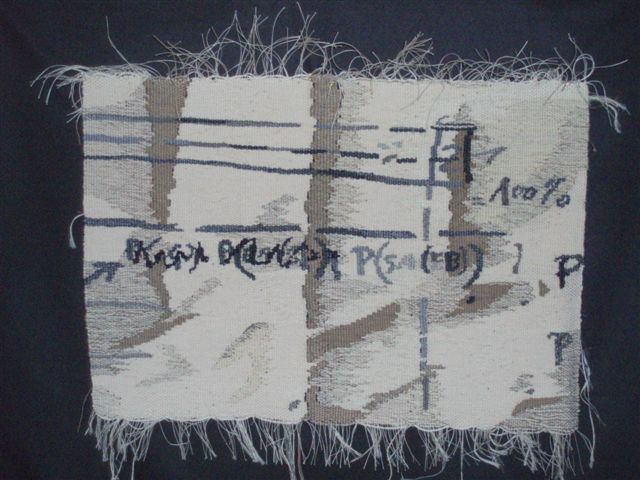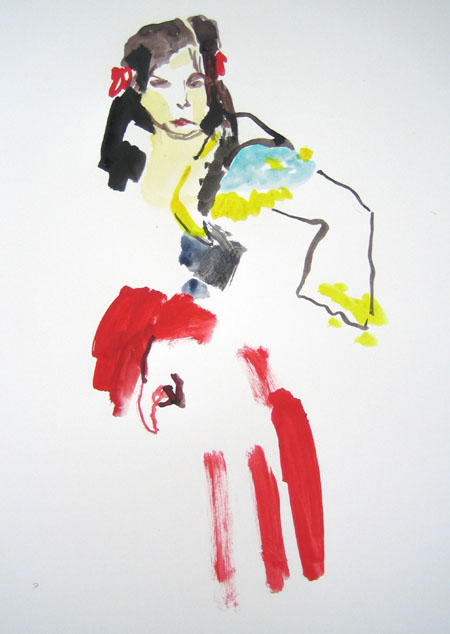Ingrid Wiener: Erste Schritte auf dem Weg zu Bayes # 7
Thursday, April 24th, 2008
Ingrid Wiener: Erste Schritte auf dem Weg zu Bayes # 7, Gobelin 2007, 34×50cm nach Blei- und Filzstiftnotizen auf DIN A4

Ingrid Wiener: Erste Schritte auf dem Weg zu Bayes # 7, Gobelin 2007, 34×50cm nach Blei- und Filzstiftnotizen auf DIN A4
The materialist mathematics of the 17th century was a subversive mathematics. Instead of imposing order on a chaotic world, materialist mathematics started with the world as it is, and abstracted from it. Traditional mathematics, exemplified by Euclidean geometry, was a “mathematics from above”, bestowing divine order on a recalcitrant world. The indivisiblist methods of Cavalieri and Harriot were a “mathematics from below,” deriving truth from the world as it is. Hierarchy and order vs. egalitarianism and the risk of chaos; such were the politics of early modern mathematics.

Ingrid Wiener: Erste Schritte auf dem Weg zu Bayes # 6, Gobelin 2007, 34×50cm nach Blei- und Filzstiftnotizen auf DIN A4
Geometrical figures are like pieces of cloth. The Italian mathematician Bonaventura Cavalieri (1598-1647) thought so, and invited others to think in this way: “plane figures should be conceived by us as pieces of cloth are made up of parallel threads” he wrote in his Geometria Indivisibilibus of 1635. “And solids are like books, which are composed of parallel pages.”
Cavalieri’s view counted for much, because he was widely credited as a founder of infinitesimal mathematics, which led ultimately to the Calculus. His teacher Galileo believed that infinitesimals were like threads, which woven together make up a rope, and their English contemporary Thomas Harriot (1560-1621) argued that the mathematical continuum is made up of points in the same way that a physical body is composed of atoms. In the 17th century, geometrical bodies were material objects, complex tapestries of interwoven lines, points, surfaces.

verpflichtet, anders zu denken,
dem Griff der Ökonomie, der Verkehrsformen, der Normen der Handelwege und Börsenbetriebe, der Rohstoffsammlung und -vermarktung (Sammelbleche) zu entgehen, indem man anders gewichtet, persönlich wird, wo es nicht verlangt wird, allgemein wird, wo es nicht schicklich ist.
Weltbürgerschaft
verpflichtet, anders zu fühlen: Tod, Explosion, Armut, Gewalt
persönlich aufzufassen, z.B. den Tod der herzkranken Frau in der Moskauer Gurjanowstrasse, die mit der Axt erschlagen wurde, weil sie vermutlich dem russischen Geheimdienst in die Quere kam,
Weltbürgerschaft
verpflichtet, anders zu denken: Tod, Explosion, Armut, Gewalt
allgemein zu nehmen, z.B. die Aufregung, die öffentlich um die Person Marcel Ospel getrieben wird, in ihrer Systematik zu begreifen, anstatt dabei Genugtuung zu empfinden.
Mit Webbildern und Aquarellen gestaltet Ingrid Wiener ein Panorama des Träumens. Es sind kleine Monumente der Innerlichkeit – und reflektierte Erholung in einem Kunstbetrieb, der mehr denn je von maßloser Geschäftigkeit lebt. … Elke Schmitter
Auf uns kommen Maße, die relativ vertraut erscheinen,
zunehmend erweisen sie sich als fremd, fremder.
Kunstspaziergänger teilen dazu mit:
Seit Jahrtausenden dringt ihre Qual in das Mark des europäischen Selbstverständnisses, in das Mark der Ökonomie (Haushaltskunde), die da behauptet, dass sich ein Wesen dem anderen unterzuordnen hat.